Experts Baffled By Mysterious Underground Chambers
26 July 2011
Via sott.net
A cave explorer crawls through an arched section of cave passage.
There are more than 700 curious tunnel networks in Bavaria, but their purpose remains a mystery. Were they built as graves for the souls of the dead, as ritual spaces or as hideaways from marauding bandits? Archeologists are now exploring the subterranean vaults to unravel their secrets.
Beate Greithanner, a dairy farmer, is barefoot as she walks up the lush meadows of the Doblberg, a mountain in Bavaria set against a backdrop of snow-capped Alpine peaks. She stops and points to a hole in the ground. "This is where the cow was grazing," she says. "Suddenly she fell in, up to her hips."
A crater had opened up beneath the unfortunate cow.
On the day after the bovine mishap, Greithanner's husband Rudi examined the hole. He was curious, so he poked his head inside and craned his neck to peer into the darkness. Could it be a hiding place for some sort of treasure, he wondered? As he climbed into the hole to investigate, it turned out to be a narrow, damp tunnel that led diagonally into the earth, like the bowels of some giant dinosaur.
Suddenly the farmer could no longer hear anything from above. He panicked when he realized that it was getting difficult to breathe the stifling air -- and quickly ended his brief exploration.
The Greithanners, from the town of Glonn near Munich, are the owners of a strange subterranean landmark. A labyrinth of vaults known as an "Erdstall" runs underneath their property. It is at least 25 meters (82 feet) long and likely stems from the Middle Ages. Some believe that it was built as a dwelling for helpful goblins.
The geologists and land surveyors who appeared on Greithanner's property at the end of June were determined to get to the bottom of the mystery. Three members of a group called the "Working Group for Erdstall Research," wearing red protective suits and helmets, dragged the heavy concrete plate away from the entrance and disappeared into the depths.
Their leader, Dieter Ahlborn, began by crawling through a passageway only about 70 centimeters (2 foot 3 inches) high. His colleague Andreas Mittermüller had to return to the surface when the lack of oxygen in the tunnel gave him a headache. Ahlborn continued crawling into the space until his lamp revealed a decayed piece of wood.
He picked it up as if it were a precious stone, knowing that it could offer an important clue about the age of the manmade cave.
Meanwhile, in the meadow above, a group from the State Office of Historic Preservation in Munich had marked off the site with colored tape. Then they rolled a three-wheeled cart equipped with ground-penetrating radar across the grass. "The gallery has collapsed at the back," one member of the group explains. "We're figuring out its actual size."
The exploration of the site is a pioneering activity, marking the first time an archeological agency in Germany is showing an interest in an extremely unusual ancient phenomenon. Similar small underground labyrinths have been found across Europe, from Hungary to Spain, but no one knows why they were built.
At least 700 of these chambers have been found in Bavaria alone, along with about 500 in Austria. In the local vernacular, they have fanciful names such as "Schrazelloch" ("goblin hole") or "Alraunenhöhle" ("mandrake cave"). They were supposedly built by elves, and legend has it that gnomes lived inside. According to some sagas, they were parts of long escape tunnels from castles.
In reality, the tunnels are often only 20 to 50 meters long. The larger passageways are big enough so that people can walk through them in a hunched position, but some tunnels are so small that explorers have to get down on all fours. The tiniest passageways, known as "Schlupfe" ("slips"), are barely 40 centimeters (16 inches) in diameter.
The ground beneath the southern German state of Bavaria is literally perforated with these underground mazes -- and no one knows why.
Many galleries are connected to the sites of former settlements. The tunnel entrances are sometimes located in the kitchens of old farmhouses, near churches and cemeteries or in the middle of a forest. The atmosphere inside is dark and oppressive, much as it would be inside an animal den.
'Completely Hushed Up'
For those curious to see what it's like inside the tunnels, innkeeper Vinzenz Wösner offers tours, or "guided crawls," in Münzkirchen, a town in northern Austria.
The tour begins in the taproom and proceeds down a stone stairway into the cider cellar, where there is a trap door that opens into a gaping hole. "We don't let people with heart conditions do the tour," Wösner says in his thick Austrian accent. He keeps a large sling on hand for emergencies, so that if anyone faints he can pull them out of the narrow tunnel.
The vaults could not have served a practical purpose, as dwellings or to store food, for example, if only because the tunnels are so inconveniently narrow in places. Besides, some fill up with water in the winter. Also, the lack of evidence of feces indicates that they were not used to house livestock.
There is not a single written record of the construction of an Erdstall dating from the medieval period. "The tunnels were completely hushed up," says Ahlborn.
Archeologists have also been surprised to find that the tunnels are almost completely empty and appear to be swept clean, as if they were abodes for the spirits. One gallery contained an iron plowshare, while heavy millstones were found in three others. Virtually nothing else has turned up in the vaults.
Until recently, the secret caves were explored only by amateur archeologists. The pioneer of Erdstall exploration, Lambert Karner (1841 to 1909), was a priest. According to his records, he crawled through 400 vaults, lit only by flickering candlelight, with "strange winding passages" through which "one can often only force oneself like a worm."
The tunnels later became the realm of local historians armed with vivid imaginations. They speculated that the caves were used as "winter quarters by the Teutonic tribes" or as dungeons for the disabled. Some of today's more esoteric souls interpret them as "spaces of nonbeing."
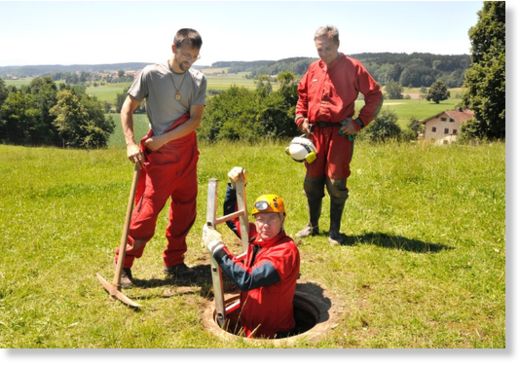
There are more than 700 curious underground passageways in Bavaria, but their purpose remains a mystery. Here, SPIEGEL reporter Matthias Schulz (middle) enters an "Erdstall," as the tunnels are known, together with experts Dieter Ahlborn (right) and Andreas Mittermüller (left).
Now Ahlborn wants to finally apply the more precise tools of science to the vaults. Under his leadership, the Erdstall working group has developed into a serious and effective group of experts. It includes cave researchers, geography teachers and engineers like Nikolaus Arndt, who has built subways in India and pipelines for fossil groundwater through the Libyan deserts for Gadhafi.
At their annual meeting, the amateur explorers combine shoptalk with bold subterranean expeditions. To avoid suffocating, says one member of the group, they recently blew air into a tunnel with a "reversible vacuum cleaner."
An exhibition in the Bavarian city of Passau now makes the subject of these mysterious galleries more accessible to a broader public. One of the hands-on exhibits is a tunnel made of plywood. Posters refer to the actual tunnels as "Central Europe's last great mystery."
The show is generating urgently needed attention. Road and construction crews often stumble upon subterranean galleries, and not knowing what they are, promptly fill them up with dirt.
The owner of the biggest complex in Germany, which is 125 meters long, built a swimming pool above it. Arndt calls it "a disgrace." However, some 90 percent of the catacombs are still believed to be intact and undiscovered.
The story of Josef Wasmeier from Beutelsbach in Lower Bavaria shows how difficult it is to track them down. There was once a castle not far from his farmstead. It was torn down in the 18th century, and now there is a grove of locust trees on the site.
"According to the legend, there were escape tunnels emanating from the castle hill," says Wasmeier. He and a few friends decided to search for the tunnels. They dug and drilled, day in and day out. "In the end, the only one still digging was Rudi Eichschmied -- every evening, sometimes in the moonlight," says Wasmeier.
The man finally came across an underground cavity.
It led to a unique gallery with walls made of sand. Initially the tunnel went down vertically for 4 meters, and then it continued in a zigzag pattern. There was a narrow "Schlupf" section at the end of the labyrinth. It reminds the researchers of a vagina.
Wasmeier once took a group of female healers down into his cave. The women slid headlong through the tunnel, in complete darkness, as if passing through a birth canal.
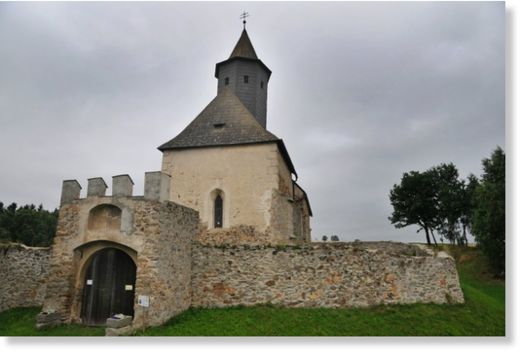
There is an Erdstall tunnel complex under this church in Kleinzwettel, Austria
The farmer sometimes feels a sense of reverence when he goes into his tunnel. "You feel like a Hopi Indian inside," he says. "They too used to sit in caves in the hope of finding answers."
'Gateways to the Underworld'
But how old is the vault? The members of the task force were so eager to find an answer that they paid for pollen analyses out of their own pockets.
A few radiocarbon dating analyses have also been performed, and they indicate that the galleries date back to the 10th to the 13th century. Bits of charcoal recovered from the Erdstall tunnels in Höcherlmühle date back to the period between 950 and 1050 A.D.
Heinrich Kusch, a prehistorian from the Austrian city of Graz, believes that these results are incorrect. He suspects that some of the subterranean systems were built about 5,000 years ago, in the Neolithic period. For several years now, he has been probing Austria's Steiermark region with giant drills for "gateways to the underworld."
But Kusch's theory has lost some of its appeal. All of the radiocarbon dating analyses completed to date indicate that the tunnels were built in the Middle Ages, challenging the validity of the prevailing school of thought. It holds that the tunnels were built during the Migration Period (known as the "Völkerwanderung" in German) in the 5th and 6th centuries, when entire tribes left their homes and abandoned the cemeteries of their ancestors. The assumption was that the tunnels and galleries were created so that the dead could still be venerated.
It is clear, at any rate, that they were built by professionals. They dug the tunnels in a kneeling position, using wedge-shaped tools held with both hands. Every few meters, they chiseled cavities into the walls for their oil lamps. They dug the longer passageways in serpentine form to reduce the pressure from the surrounding earth. Supporting planks were not used.
Around the year 1200, the underground labyrinths were filled in and the entrances blocked with rubble. The rubble contained ceramics clearly attributable to the Gothic period.
The confusion over the tunnels is hardly surprising. Some believe that they were used as dungeons for criminals, while others see them as places of healing, where the sick could cast off their afflictions. Still others speculate that they were used by druids.
As a result of the international cooperation of the Erdstall working group, new clues have come to light. The galleries are also concentrated in parts of Ireland and Scotland, and there are also clusters in central France.
This distribution bears intriguing parallels to the routes of the Irish-Scottish traveling monks who, coming from the Celtic north in the 6th century, traveled across the continent as missionaries. The tattooed monks made the passage to the continent from the islands, carrying long staffs and wearing coarse habits.
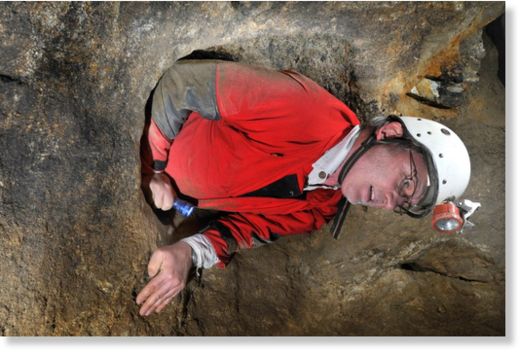
Weichenberger in a tunnel complex in Reichersberg. Some of the passages are so narrow that one has to squeeze through them
The legendary Kilian, born in Ireland around 640 A.D., preached in the southern German city of Würzburg. According to a hagiography, angry natives killed him and buried him in a stable. St. Gall (died 640 A.D.) made it as far as Lake Constance.
Ahlborn speculates that these early Christian missionaries also brought along heathen ideas, the remnants of Druid scholarship or special Celtic concepts of the afterlife, which led to the construction of the subterranean galleries.
Perhaps the tunnels were also prisons for demons, evil dwarves and the undead. Some galleries contain traces of building stones and remnants of doors or locks. A sandstone relief was found in an Erdstall at Bösenreutin near the town of Lindau on Lake Constance. It depicts a goblin with a tail attached to its rump.
Were the galleries temples for the superstitious?
Hiding from Bandits
Not everyone finds these spiritual interpretations convincing. Josef Weichenberger can only shake his head when he hears them. He is talking himself into a rage as he speeds from the Bavarian city of Passau toward the Waldviertel region in Lower Austria. "The cult theories are completely erroneous."
Then he offers his interpretation: "The Erdstall galleries were simply hiding places."
Weichenberger's opinion carries some weight. An archivist by profession, he has been crawling through the labyrinths for the last 34 years. He also runs an alarm center from his office. When construction workers report the discovery of an Erdstall, he rushes to the site to document it with a compass and a measuring tape.
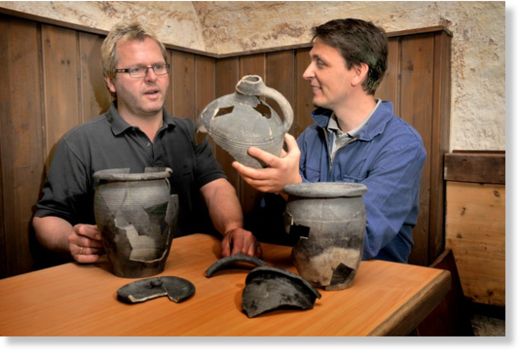
Austrian archaeologist Heinz Gruber (right) shows restored clay pots that were found in tunnels. On the left is Vinzenz Vösner, who owns an Erdstall located under his inn
For this mole of a man, no tunnel is too narrow and no passageway too moist or dirty.
According to Weichenberger, the galleries in his native Austria were built during the "medieval clearing period" in the 11th century. At the time, settlers from Bavaria traveled down the Danube to cultivate land in the east.
Armed with hatchets, they cut swaths into the wilderness. It was not an entirely safe undertaking. Magyars flooded into the area around 1042. Around 1700, the Hungarian rebels known as Kurucs, with the backing of the Ottoman Turks, ransacked the countryside.
Robbers also posed a threat in the region. They raided remote villages and used crowbars to get into the houses. Weichenberger believes that the farmers quickly fled underground "from this vermin," taking their valuables with them.
In Weichenberger's version of the mystery of the subterranean galleries, the terrified villagers would sit in their hiding places underground, their hearts pounding, while the intruders raged above ground, searching in vain for valuables.
He also offers written evidence. "An old account of a death tells the story of a woman who was so afraid of being discovered that she suffocated her screaming baby in an Erdstall."
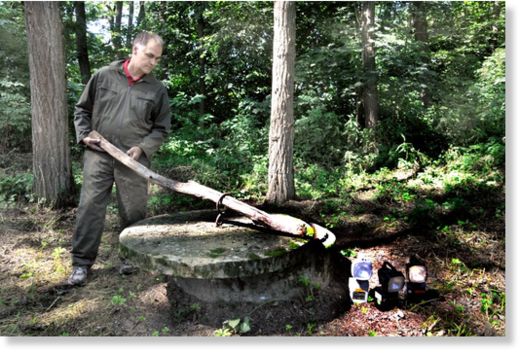
Farmer Josef Wasmeier has an Erdstall tunnel complex on his property in Unterholzen
With his talk of "murder," "bandits" and people "shaking in terror as they hid underground," Weichenberger makes ancient Austria sound like a lawless region not unlike the Wild West. "That's just the way it was," he says, as he continues to drive eastward. It's the same route the settlers once followed as they cleared the forests in the east.
After four hours on the road, we approach the Kleinzwettl fortified church. The ruins once included a drawbridge and a circular rampart. As churches go, it must have been a veritable fortress.
There is also a system of passageways directly beneath the church. When he surveyed it last November, Weichenberger determined that it was 62 meters long. The entrance is under the granite cobblestones in the sanctuary.
A special permit is needed to enter the dim vault, because of the danger of collapse. At first, we make our way through a muddy, serpentine passageway.
The tunnel gradually becomes narrower. A water leak has transformed the rear section into a mud pit. Water drips from the ceiling. The thought of the heavy church columns resting on the ground above is terrifying.
"It's certainly a little uncomfortable here," Weichenberger admits, "but the people were desperate to stay alive."
To substantiate his theory, Weichenberger even hazarded a survival experiment. He and two colleagues were locked into an Erdstall for 48 hours. The oxygen monitors were soon beeping and the candles they had brought along started flickering oddly. The men dozed away, and whenever breathing became too difficult they crawled into other tunnels. The test was a success.
But what does it prove?
"Some galleries were indeed used as hiding places, but only much later," says Ahlborn, promptly dismissing his rival's theory. "They were also uses as toilets and refuse pits."
Austrian spelunker Edith Bednarik is also certain that the convoluted grottoes could not have been used as hiding places. She offers several arguments to support her case. For one, there are hardly any larger chambers where people could have stayed. The galleries have no "emergency exits," and if there were a fire they would have become "deadly traps." Besides, the smallest tunnels were too narrow for pregnant women.
Besides, if the terrified villagers were tightly packed into the subterranean vaults during attacks, why did nothing fall out of anyone's pockets? There are no food remains or traces of torches.
For these reasons, most experts attribute a sacred and ritual function to the underground landmarks. Many find the idea of a "chamber of souls" particularly attractive.
According to this theory, the galleries were essentially waiting rooms in which the souls of the dead were to spend the period until the Second Coming of Christ -- the Day of Judgment, when Jesus Christ would judge "the living and the dead."
It wasn't until the 12th century that the theology of purgatory became established, which made it possible for souls to become purified. This meant that good people could ascend to heaven right away. The caves would have been useless at that time, which corresponds to the period when they were filled in.
But even this view doesn't explain why the sacred vaults were kept such a secret. And why are there no Erdstalls in Switzerland or in the Black Forest?
For now, the mystery must remain unsolved. "We could use the help of physicists with radiocarbon dating expertise, theologists and specialists in prehistoric mining," says Ahlborn. Not a single doctoral thesis has been written on the subject to date. The dark tunnels are still virtually unknown among academics.
This doesn't trouble farmer Josef Wasmeier. He loves his Erdstall, particularly because of its mysterious aura. Sometimes he crawls into his sandy private cave for half an hour in the evening and meditates. It's "completely quiet" inside, he says, dark and distant like a womb.
"And when I climb back up again, the stars seem so bright you feel you could almost touch them."
Source: Der Spiegel
Translated from the German by Christopher Sultan
You need to be a member of Ashtar Command - Spiritual Community to add comments!

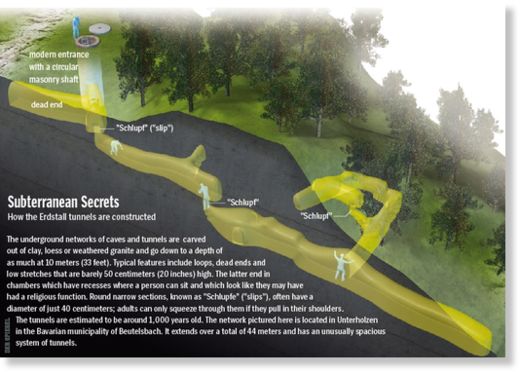
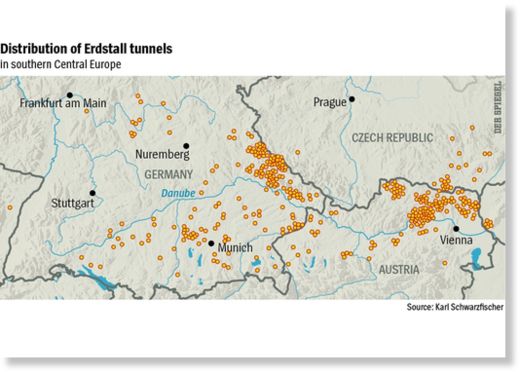
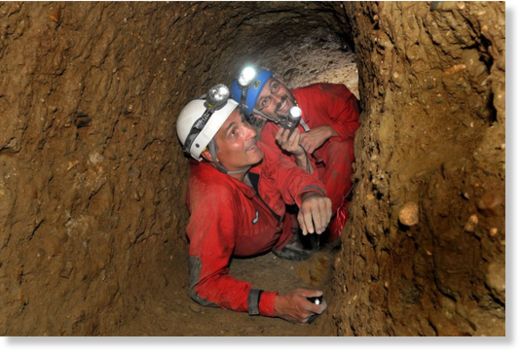
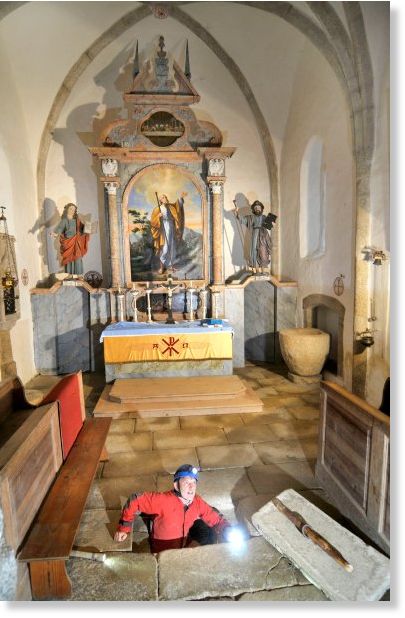
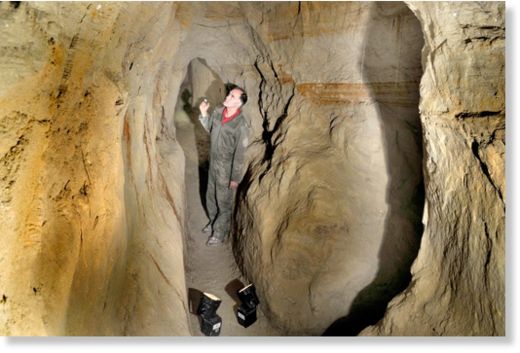




Replies
If Our Time Machine has to become of anything, MY only concern is just an issue, as follows, Its Tachyon Engine, operable by a gamma source, one that I don't feel that I can hide from you, any suggestions, please? Greetings, 'J.A.,' Ifounditt etc., there to be continued.